Dark Green Religion in Europe: Perilous Specter or Promising Movement?
By Bron Taylor
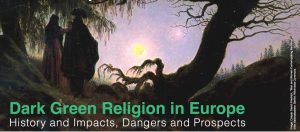
In April 2024 a conference titled Dark Green Religion in Europe: History & Impacts; Dangers & Prospects took place at the Leibniz-Institute of European History in Mainz, Germany. For three days scholars wrestled with the argument and evidence I advanced in Dark Green Religion: Nature Spirituality and the Planetary Future (which was subsequently translated by Kocku von Stuckrad and published in Germany as Dunkelgrüne Religion).
The gathering focused on such phenomena in Europe.
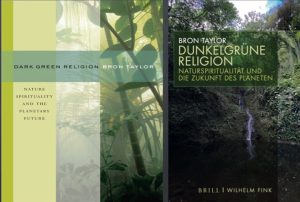
In DGR (which is my abbreviation here for the book title) I argued that if we begin with a flexible definition of religion, looking in the global environmental milieu for its religion-resembling dimensions, it is possible to perceive rapidly growing and influential forms of nature spirituality.
Specifically, I argued that spiritualities that stress ecological interdependence and mutual dependence, involve deep feelings of belonging and connection to nature, and express beliefs that the biosphere is a sacred, Gaia-like superorganism, have been assuming new forms and exercising increasing social and political influence.
These sorts of nature-based spiritualities generally cohere with and draw on an evolutionary and ecological worldview, and therefore stress continuity and even kinship among all organisms. These spiritualities also often have what can be called animistic dimensions, wherein people think communication (if not also communion) with non-human organisms is possible.
Both animistic and Gaian perceptions can involve beliefs in divine entities or forces (e.g., spirits animate certain organisms or natural entities, or the world as a whole is divine, as in various forms of Pantheism [i.e., the idea that everything in nature is divine]). Conversely, animistic and Gaian perceptions can be entirely naturalistic, rooted in the sciences or personal experiences with non-human organisms. The following chart illustrates these types:
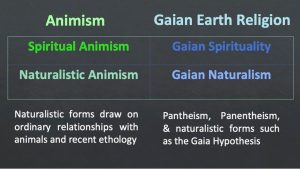
The naturalistic forms of animism draw on ordinary relationships people have with animals, as well as on ethology, the science of animal consciousness and behavior. The naturalistic, Gaian forms are typically blended with ecology-based understandings of interconnectedness, including the Gaia Hypothesis, as advanced by atmospheric scientist James Lovelock.
Uniting these Gaian and animistic perceptions, I argued, is a deep sense of humility about the human place in the universe, in contrast to anthropocentric conceits, wherein human beings consider themselves to be superior to other living things and the only ones whose interests count morally.
And regardless of whether such perceptions are conventionally religious in some way or entirely naturalistic, the perceptions that are common in DGR lead to reverence for individual organisms and species, as well as for the biosphere as a whole.
In addition to arguing that there are growing animistic and Gaian trends around the world, and that these have forms that are both obviously religious (according to essentialist definitions requiring perception of non-material beings or forces of some kind), and entirely naturalistic (involving no such beliefs and typically drawing strongly on the sciences), I suggested that the following traits are the most typical among those involved in what I construed as dark green spirituality:
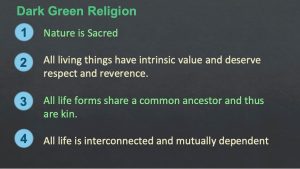
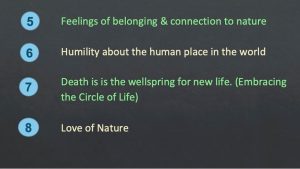
In DGR I documented how scientists, environmental philosophers, historians, and other scholars, as well as environmental activists, artists, musicians, filmmakers, nature writers, literary critics, museum and aquarium curators, among many others, are expressing and promoting such understandings.
I further argued that, although such spiritualities are nascent and relatively small compared to the world’s predominant religions, they are gaining adherents and cultural traction around the world, promoting proenvironmental policies and behaviors, and exercising at least some political influence.
Moreover, I suggested, dark green spiritualities, are more likely to kindle dramatic environmental mobilization than are the world’s longstanding religious traditions. Indeed, those involved in DGR often criticize the world’s predominant religions, contending their beliefs and practices hinder proenvironmental values and behaviors. (For a pithy analysis of related scholarly research see Religion and Environmental Behaviour (part one): World Religions & the Fate of the Earth and Religion and Environmental Behaviour (part two): Dark-green Nature Spiritualities and the Fate of the Earth; both are available open access in The Ecological Citizen.)
Flipping that coin, I also explored the views of those who regard dark green spiritualities as spiritually, politically, or economically dangerous. Still other critics objected to the characterizations often made by those promoting dark green spiritualities arguing contrarywise that the world’s longstanding religious traditions do enjoin proenvironmental behaviors.
Put simply, my argument is that there is a little noticed but culturally important convergence toward what I called DGR and that this has led to a significant and growing debate, including at the Dark Green Religion in Europe conference in Mainz
At the invitation of the co-directors of Counterpoint, therefore, I have here introduced the DGR framework, the ferment, and some of the controversies, that dark green spiritualities have evoked. In the weeks that follow, many of the conference participants will dig deeper than I could into DGR-related phenomena, and the many related contentions and controversies they precipitate, while focusing particularly on Europe.
Readers of this unfolding Counterpoint series will therefore be able to explore the question with which I wrapped up the book’s prologue, namely, “whether the emergence and global diffusion of Dark Green Religion is a harbinger of hope, or a portent of doom.”
#
Bron Taylor is Professor of Religion and Environmental Ethics at the University of Florida. An interdisciplinary environmental studies scholar, he explores through the lenses of the sciences and humanities the complex relationships and influences among worldviews, values, ideologies, and socioecological systems. His books include Dark Green Religion: Nature Spirituality and the Planetary Future (2010), Avatar and Nature Spirituality (2013), and Ecological Resistance Movements (1995). He is also editor of the award-winning Encyclopedia of Religion and Nature (2005), and has been appointed as a Carson Fellow at the Rachel Carson Center for Environment and Society at Ludwig-Maximilians-Universität, Munich, Germany, and as a Senior Research Fellow at the Leibnitz Institute for European History in Mainz, Germany. In 2017, he received a Lifetime Achievement award from the International Society for the Study of Religion, Nature and Culture. Downloadable articles and further information is available at www.brontaylor.com and via X @BronTaylor.
Counterpoint blogs may be reprinted with the following acknowledgement: “This article was published by Counterpoint: Navigating Knowledge on 24 May 2024.”
The views and opinions expressed on this website, in its publications, and in comments made in response to the site and publications are those of the author(s) and do not necessarily reflect the views and opinions of Counterpoint: Navigating Knowledge, its founders, its staff, or any agent or institution affiliated with it, nor those of the institution(s) with which the author is affiliated. Counterpoint exists to promote vigorous debate within and across knowledge systems and therefore publishes a wide variety of views and opinions in the interests of open conversation and dialogue.
Image credit: Conference poster of the Leibniz-Institute of European History in Mainz, Germany, using a freely available painting by Caspar David Friedrich.
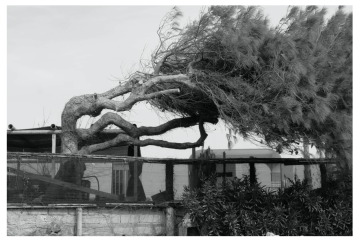

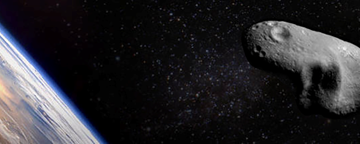

3 Comments
FFE · June 3, 2024 at 1:34 AM
I once had a Native American studies professor who mentioned the words “nature” and “religion” did not exist in indigenous languages because they refer to the basic matrix of reality that is taken for granted. Not sure what to do with that but it was interesting to think about. Looking forward to the ideas and writings that come out of this conference.
The Ecofascist Potentials of Dark Green Religion? - Counterpoint: Navigating Knowledge · June 17, 2024 at 2:22 PM
[…] Bron Taylor points out on this blog, given the increasing social and political influence of dark green religion, one […]
“The Journey of Pachamama” – Dark Green Christianity in West Germany During the 1980s - Counterpoint: Navigating Knowledge · September 3, 2024 at 5:37 AM
[…] ideas resemble the core elements of what Bron Taylor defines as “Dark Green Religion” […]